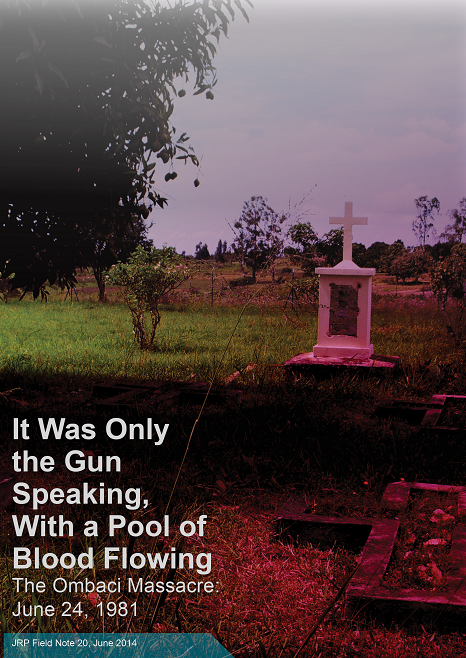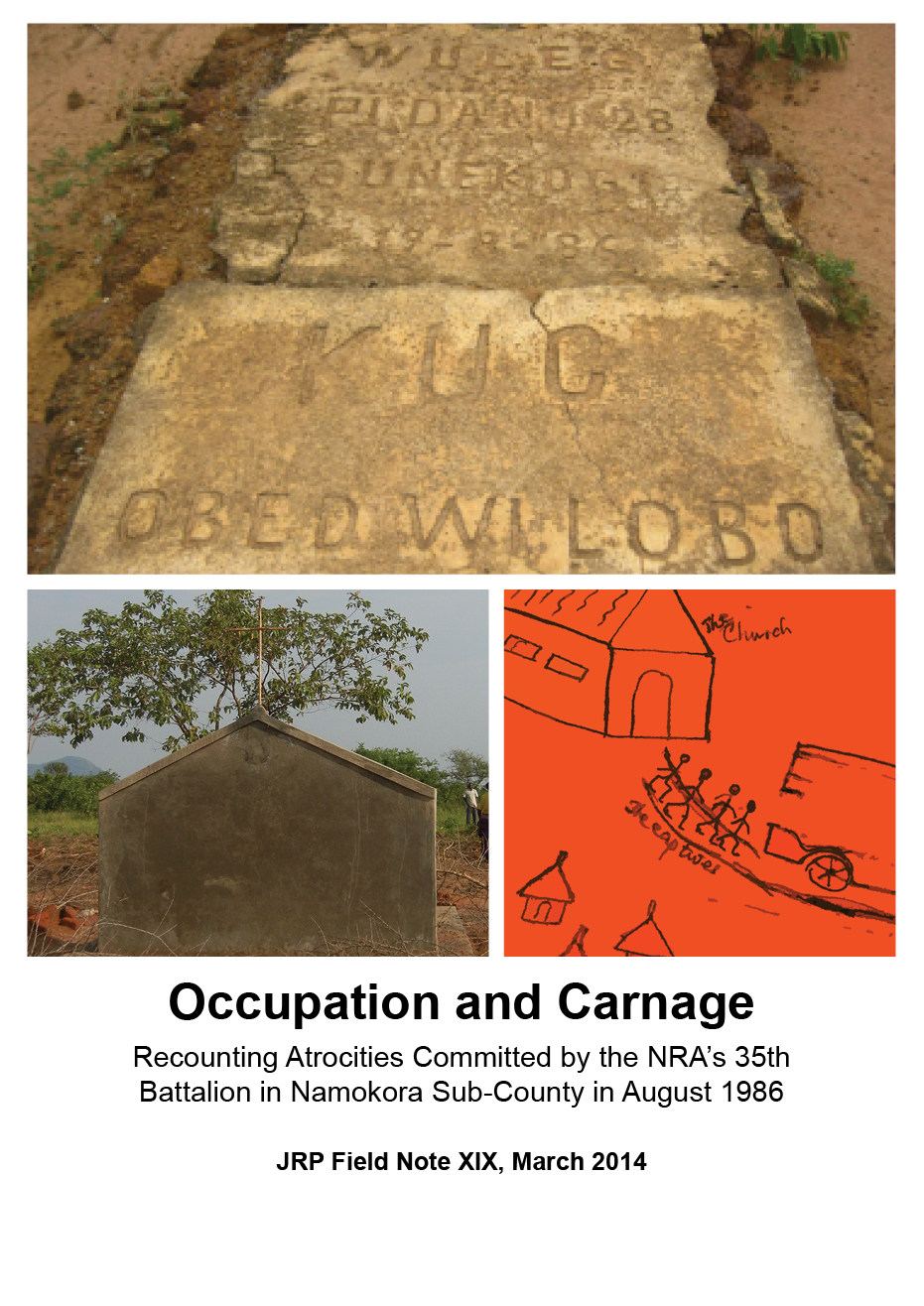
Download: 2013 Annual Report (pdf)

Download: 2013 Annual Report (pdf)


On 24 June 2014, JRP attended the second annual memorial of the Ombaci Massacre of 1981 at the Ombaci Catholic Mission, Arua in the West Nile sub-region of northern Uganda. The event, organised by members of the Ombaci War Victim’s Association, consisted of a memorial prayer led by the Bishop of Arua diocese, the Rt. Rev. Sabino Odoki, and a follow-up event, which included presentations by survivors of the massacre. In his speech, Bishop Odoki called upon the people to speak out against oppression, crimes and human rights violations. He also called for reconciliation among the peoples of West Nile, and with those outside of the sub-region. He also identified the trauma that still exists for victims of massacres like those in Ombaci as needing to be addressed.
The event was also attended by Bernard Atiku, the Member of Parliament for Ayivu county in Arua, who pledged to work with the survivors group to improve the massacre memorial site, as well as the Arua Resident District Commissioner (RDC), Peter Debele, among others.
The event concluded with the launch of JRP’s 20th Field Note It Was Only the Gun Speaking, With a Pool of Blood Flowing: the Ombaci Massacre June 24, 1981.
After years of engaging with survivors of conflict in northern Uganda, the Justice and Reconciliation Project’s work has revealed sexual and gender based violence as one of the most complex defining characteristics of the war that took place in the region. As such, addressing the issue has proven to be one of the biggest challenges facing peace-builders. In JRP’s recent Field Note – The Beasts at Burcoro – community members describe the molestation, rape and torture both men and women suffered at the hands of the National Resistance Army’s 22nd Battalion in 1991. Over twenty years after the occurrence, many survivors still harbour the lingering effects of the attack because mechanisms designed to address their specific needs have not been provided for them. This issue of Voices magazine deals with this very relevant aspect of transitional justice today, and examines the ways in which it can be addressed. Read more here (pdf)
Read the entire issue here: Voices Issue 07 (pdf)

Located just 4 kilometres north-west of Arua town on the Kaya Highway/Rhino Camp Road, in Arua District is Ombaci College. On Wednesday, June 24, 1981, the Uganda National Liberation Army (UNLA) attacked civilians who had taken refuge at Ombaci Colleges, claiming the lives of close to 100 people and leaving countless wounded.
This report presents a detailed account of what took place during the Ombaci Massacre and the lasting effect it has had on the survivors based on individual interviews and focus group discussions with survivors and relatives of the victims.
The massacre was by all accounts extremely chaotic, with groups of soldiers entering from all sides of the school and mission, and roving from room to room shooting and looting. This highlights the challenges survivors continue to face and make a number of recommendations which arose from our interviews, chiefly a call for compensation of survivors, as well as support for livelihoods, education, and reconciliation.
Read the entire report here:

Are you interested in contributing to the next issue of Voices magazine? We welcome guest articles from 700 – 1000 words. Email your contributions to voices@justiceandreconciliation.com.
Read previous issues of the magazine here.
 Download this report here: TJ Quiz Issue Report (pdf).
Download this report here: TJ Quiz Issue Report (pdf).
 Download this report here: Lukodi Issue Report (pdf)
Download this report here: Lukodi Issue Report (pdf)
Women’s Advocacy Network petition unanimously adopted by Parliament

KAMPALA – On 9 April 2014, the Ugandan Parliament adopted a resolution calling for the establishment of a “gender sensitive reparations fund” and the offering of reparations for war-affected women and men. The resolution also calls for the government to provide free and accessible health services for war-affected women and children as well as to ensure the integration and resettlement of children born in captivity and formerly-abducted women in their communities.
This comes as a result of a motion tabled by Aswa County, Gulu District Member of Parliament Hon. Ronald Reagan Okumu on 3 April. It also comes on the heels of intense lobbying by civil society organisations such as the Justice and Reconciliation Project, a non-governmental organisation in Gulu, and specifically a petition presented by a collective of war-affected women known as the Women’s Advocacy Network (WAN) to the Uganda Women Parliamentarian’s Association in March.
After the adoption of the resolution, the Deputy Speaker of Parliament, Rt. Hon. Jacob Oulanya appointed a three member committee consisting of Hon. Rosemary Nyakingogoro, Hon. Reagan Okumu and Hon. Godfrey Kiwanda to follow up on the government’s implementation of the resolution and to update Parliament accordingly.
“This has begun the process of healing for me,” the chairperson of the Women’s Advocacy Network, Evelyn Amony said after hearing the news, “We plan to work to push for the issues we have raised until they are addressed. We also hope to meet the president of Uganda to let him know what we are going through and for him to understand the urgency of our needs.”
The resolution has been deemed a “success” and a “milestone” according to a statement issued by the Justice and Reconciliation Project.
“It has been six years since the government of Uganda undertook to establish measures that would ensure justice for victims of atrocities committed during the insurgency in northern Uganda. To date very little has been done to redress the harm that victims suffered but this landmark parliamentary resolution marks the beginning of healing and the restoration of dignity for many victims,” the organisation is quoted as saying.
###
Download this press release here (pdf): Press release 2014-04-10


Namokora is located 56 kilometres east of Kitgum town and is one of the sub-counties that frequently come up when there are discussions or debates regarding state orchestrated abuses in northern Uganda. On the 19th of August 1986, the 35th Battalion of the National Resistance Army (NRA) allegedly massacred up to 71 men and women from Namokora and other surrounding sub-counties in a lorry at Wiigweng in Oryang village, and Namokora sub-county. These men and women were accused of being rebel collaborators and/or having plans to oust the newly formed NRA government in Kampala.
Herded into the lorry, over 89 civilians founded themselves being piled onto each other with hardly any space as they were driven to an unknown destination while being closely followed by a white pickup filled with armed NRA soldiers. After driving for about three kilometes, they were indiscriminately shot at, resulting in the death of 71 men and women and the injury of scores of others. Since burials did not happen immediately after the shooting most of the bodies were feasted on by dogs and other beasts within that area.
This report provides narratives of key events leading to the Namokora massacre of 1986 based on the testimonies of survivors and relatives. It also looks at developments in that community from 1986 to date and makes specific recommendations to the government and non-governmental organisations to provide compensation to the survivors of the massacre, to address the health consequences of the NRA operation in Namokora and to support the formation of a community based victims support groups.
Read the entire Field Note here: Namokora (pdf)
 This week, members of the Women’s Advocacy Network (WAN) delivered a long anticipated petition to the Uganda Women Parliamentarian’s Association (UWOPA). The petition calls for, among other things, a comprehensive reparations programme to be instituted, the prioritisation of reparations for war-affected women and increased accessibility for reproductive and mental health services for children and women affected by conflict.
This week, members of the Women’s Advocacy Network (WAN) delivered a long anticipated petition to the Uganda Women Parliamentarian’s Association (UWOPA). The petition calls for, among other things, a comprehensive reparations programme to be instituted, the prioritisation of reparations for war-affected women and increased accessibility for reproductive and mental health services for children and women affected by conflict.
You can read the petition here.